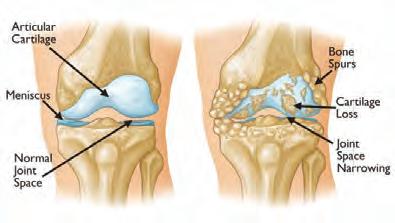
2 minute read
A Guide to Osteoarthritis of Knee Joint
A GUIDE TO OSTEOARTHRITIS OF KNEE JOINT Patient, Safety, Quality & Care by Aga Khan Hospital, Dar es Salaam
“Osteoarthritis of the knee joint is a degenerative joint disease, when articular cartilage gets worn off gradually due to wear and tear of the joint, especially after you turn 45 years. It makes the joint painful while bending and straightening. Gradually disease keeps on progressing and deformity is also noticed later in course of disease which alters the axis of weight bearing. It becomes very difficult to walk on a deformed joint. “
Advertisement
Dr. Rajeev Kumar Consultant Orthopaedics and Joint Replacement Surgeon M.B.B.S, M.S (Orthopaedics), Arthroscopy & Arthroplasty Fellow ( ISKSAA ), Life member of IAS, IAA, ISKSAA & IOA.
For more information on aAdenoid Hypertrophy, visit The Aga Khan Hospital or call us at +255 22 2344625.
When this condition reaches severe levels and all conservative management have failed such as analgesic medications, rubbing of analgesic and antiinflammatory gel, Intra-articular steroid injections in knee joint , unloading knee braces and physiotherapy, then the only treatment which can help the patient at this stage is a Total Knee Replacement. For example, when a patient has osteoarthritis in just one compartment, then the orthopedic surgeon could choose to replace the entire knee joint or to resurface just the affected compartment which is known as Unicompartment Knee Replacement.
Recent studies show good longterm survival of Unicompartmental knee replacement in comparison to High tibial osteotomy (One of the options to manage OA knee in young patients Less than 55 Years similar to Unicompartmental knee replacement).
Unicompartmental knee replacement /resurfacing (UKR) or bi-unicompartmental knee resurfacing, Gender knee, Navigation assisted TKR, Robotic assisted knee replacement are some of the new trends in operative treatment of osteoarthritis knee joints.
All Picture Courtesy of The Aga Khan Hospital, Dar es Salaam These procedures aim to restore a pain-free, fully functional and durable knee joint with fast recovery, shorter hospital stay, smaller incisions, less blood loss, faster and less painful rehabilitation, lower risk of infection, less chances of joint stiffness, less risk of venous thromboembolism and easier r evision surgery if required later. Early functional outcome is good with these procedures particularly with CAS and Robotics but longterm survival in comparison to conventional total knee replacement is yet to be established. Total knee replacement has a finite survival rate, dependent mainly upon the implant alignment, positioning of implant, balancing of knee joint and post-operative activity level of the recipient.











